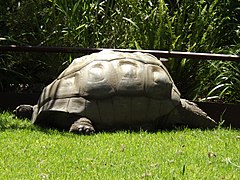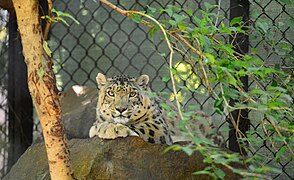bio.wikisort.org - Zoo
Melbourne Zoo is a zoo in Melbourne, Australia. It is located within Royal Park in Parkville, approximately 4 kilometres (2.5 mi) north of the centre of Melbourne. It is the primary zoo serving Melbourne. The zoo contains more than 320 animal species from Australia and around the world, and is accessible via Royal Park station on the Upfield railway line, and is also accessible via tram routes 58 and 19, as well as by bicycle on the Capital City Trail. Bicycles are not allowed inside the zoo itself.
 | |
 The main entrance to Melbourne Zoo | |
| Date opened | 6 October 1862[1] |
|---|---|
| Location | Parkville, Melbourne, Victoria, Australia |
| Coordinates | 37.784762°S 144.952095°E |
| Land area | 55 acres (22 ha) |
| No. of animals | 5,120 |
| No. of species | 320[2] |
| Memberships | Zoo and Aquarium Association,[3] World Association of Zoos and Aquariums[4] |
| Major exhibits | Elephants, lions, tigers, orang-utans, gorillas |
| Website | www |
The Royal Melbourne Zoological Gardens is a full institutional member of the Zoo and Aquarium Association and the World Association of Zoos and Aquariums.
The zoo is set among flower gardens and picnic areas. Many of the animals are now organised in bioclimatic zones: African rainforest ('Gorilla Rainforest') that include gorillas and lemurs; Asian rainforest ('Trail of the 'Elephants') that includes elephants, orangutans, tigers and otters; and the Australian bush with kangaroos, koalas, wombats, goannas, native birds and many others. Popular exhibits also include the 'Butterfly House', the 'Reptile House', the 'Great Flight Aviary', 'Wild Sea', 'Treetop Apes and Monkeys' and 'Lion Gorge'.
The zoo includes a large schools section and caters to many school visitors annually, its immensely popular education program encourages young minds to conserve animals.
Visitors can see historical cages including the heritage listed Elephant House, which has been renovated and adapted for use for customers paying to sleep overnight in tents at the zoo in popular Roar and Snore evenings. These evenings allow the public to see some of the nocturnal animals at the zoo in evening guided tours by experienced camp hosts.
History
In October 1857 the Zoological Society of Victoria was formed with the aim of introducing animals and plants from overseas.[5] Its first collections of animals were housed in Richmond Paddock.[5] In 1861 the organisation changed its name to the "Acclimatisation Society of Victoria".[5]
On 6 October 1862, the organisation opened a new Melbourne Zoo in Royal Park on 55-acre (22 ha) of land donated by the City of Melbourne. Melbourne Zoo was modelled on London Zoo.
Initially the zoo was important for the acclimatisation of domestic animals recovering from their long trip to Australia. It was only with the appointment of Albert Alexander Cochrane Le Souef in 1870 that more exotic animals were procured for public display, and the gardens and picnic areas were developed.[6] 1870 also saw the Society change its name to the "Zoological and Acclimatisation Society of Victoria", and was granted the prefix "Royal" in 1910.[5]


One of the most famous exhibits from the early 1900s to the 1940s was Queenie the elephant.
In the mid-1930s, the Society had financial troubles. In response the Zoological Gardens Act 1936 was passed, handing the Zoo to a newly appointed Zoological Board of Victoria on behalf of the state government in 1937.[5]

In 1989, a 35-year-old man died when he was partially eaten by a lion after he entered its pen.[7]
On 15 January 2010 Melbourne Zoo welcomed its first elephant calf, Mali. This is the second elephant calf born in Australia, the first being in Sydney in July 2009. Mali is the first female calf born in Australia and the first calf born via artificial insemination.
Melbourne Zoo commemorated 150 years of operation in 2012 and this was celebrated in an Australian Zoos collector's edition of stamps released by Australia Post in September 2012.
The Zoo completed construction and opened a new carnivores trail in early 2018.
Zoos Victoria
Zoos Victoria administers the Melbourne Zoo, as well as the Werribee Open Range Zoo, which features herbivorous creatures in an open-range setting; and Healesville Sanctuary (formerly the Sir Colin MacKenzie Sanctuary), which exhibits Australian fauna on 175 hectares (430 acres) of bushland.[8]
The three zoos have been collectively trading as Zoos Victoria since 1973, governed by the Zoological Parks and Gardens Board, which operates under the Zoological Parks and Gardens Act 1995.[9]
In October 2022 Kyabram Fauna Park also became part of Zoos Victoria.
Exhibits
- Gorilla Rainforest: Western lowland gorillas live in a family troop in a large habitat at the center of this area and is the major exhibit of this precinct. Other animals housed in this precinct are a pygmy hippo, a southern cassowary, black-and-white ruffed lemurs and ring-tailed lemurs. Additionally, a boardwalk following on the trail houses monkeys such as black-handed spider monkeys, northern white-cheeked gibbons, eastern black-and-white colobuses, cotton-top tamarins and emperor tamarins.
- Growing Wild: An interactive play area opened in 2012 for the zoo's 150th anniversary. There are exhibits for Aldabra giant tortoises, meerkats and blue-winged kookaburras.
- Trail Of The Elephants: Six Asian elephants — females Mek Kapah (the matriarch), Dokkoon, Kulab, 'Num-oi, Mali (daughter of Dokkoon) and Man Jai (son of Dokkoon), the herd rotates through one of the three paddocks throughout the day. The zoo used to have Ongard (son of Kulab), who is currently in Zoo Miami and an adult bull elephant named Bong Su who died in 2017 after a long battle with arthritis since 2005. Bong Su arrived at the zoo as a gift from the Sultan of Pahang as an orphan in 1997.[10] Other enclosures house Sumatran tigers, Sumatran orangutans, siamangs, Asian small-clawed otters, black-capped squirrel monkeys and a butterfly house.
- Wild Sea: Opened in 2009, this immersive $20 million development houses animals that live off the coasts of Victoria such as Australian fur seals, long-nosed fur seals, little penguins, Fiordland penguins, big-belly seahorses and some native fish. With underwater sounds and a projector screen coupled with the beautiful lighting effects it has a calming touch of realism. The penguins and seals can be viewed from above water level and below.
- Australian Bush: This trail consists of native animals such as koalas, western grey kangaroos, emus, southern hairy-nosed wombats, Tasmanian devils, lace monitors, helmeted honeyeaters and orange-bellied parrots.
- Great Flight Aviary: A large free-flight aviary within the Australian Bush precinct dating to the 1930s. Visitors walk along a boardwalk through three different bioregions representing an Australian rainforest, wetlands and bushland. Some species housed include red-collared lorikeets, red-tailed black cockatoos, blue-faced honeyeaters, eclectus parrots, pied herons, radjah shelducks and wonga pigeons.
- Lion Gorge: Two male African lions, Ndidi and Zuberi moved to the zoo from the Werribee Open Range Zoo. The precinct also contains dingoes, snow leopards, brown-nosed coatis as well as additional enclosures for Sumatran tigers and Tasmanian devils. Also included in this area is the 'DigestED' building, which houses multiple species of snakes like reticulated pythons.
- Frogs and Reptiles: World of Frogs houses several native and endangered frogs and toads, including southern corroboree frogs and the only Baw Baw frogs in captivity. The zoo's Reptile House holds a variety of native and exotic reptiles such as the coastal taipan, eastern diamondback rattlesnake, Fiji crested iguana, Gila monster, grassland earless dragon and Philippine crocodile.
- Other animals: Other animals include red pandas, giraffes, plains zebras, platypuses, blue-and-yellow macaws, red-fronted macaws, hamadryas baboons, a Malayan tapir and collared peccaries.
Gallery
- Asian elephant herd
- Orangutan
- Sumatran tiger
- Western lowland gorilla
- Pygmy hippo
- Ring-tailed lemurs
- Giraffes and zebras
- Meerkats
- Aldabra giant tortoise
- African lion
- Snow leopard
- Red pandas
- Australian fur seal
- Australian pelican
- Little penguins
- Koala
- Emu
- Platypus
- Malayan tapir
Notes
- "History of the Zoo". zoo.org.au. Zoos Victoria. Archived from the original on 19 August 2010. Retrieved 27 August 2010.
- "About Melbourne Zoo". zoo.org.au. Zoos Victoria. Archived from the original on 2 July 2010. Retrieved 27 August 2010.
- "Member Location Map". zooaquarium.org.au. ZAA. Retrieved 29 January 2011.
- "Zoos and Aquariums of the World". waza.org. WAZA. Retrieved 29 January 2011.
- "Royal Zoological and Acclimatisation Society". Research Data Australia. Retrieved 19 June 2022.
- "The Zoological Gardens". Weekly Times. No. 594. Victoria, Australia. 22 January 1881. p. 11. Retrieved 3 March 2017 – via National Library of Australia.
- "Dead man found in lion's pen at zoo". UPI. 26 March 1989.
- "About us". Zoos Victoria. Retrieved 31 March 2021.
- Zoos Victoria (2019). Annual Report 2019-2020 (PDF) (Report). Retrieved 31 March 2021.
- "Melbourne Zoo's bull elephant Bong Su dies". Herald Sun.
External links
 Media related to Melbourne Zoo at Wikimedia Commons
Media related to Melbourne Zoo at Wikimedia Commons- Official website
- List of species at Melbourne Zoo, globalspecies.org
Другой контент может иметь иную лицензию. Перед использованием материалов сайта WikiSort.org внимательно изучите правила лицензирования конкретных элементов наполнения сайта.
WikiSort.org - проект по пересортировке и дополнению контента Википедии


















